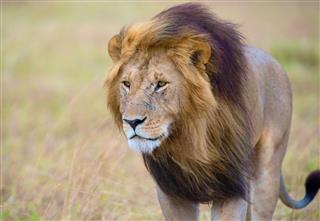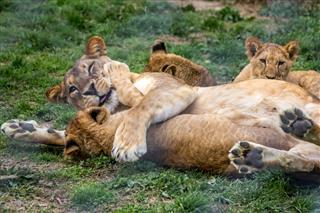
The numbers of African lions are sadly on a rapid decline. These vulnerable species face constant threat due to loss of habitat and poaching. Here are some interesting facts about African lions, and why they are still such a majestic lot, even today.
Scientific Name: Panthera leo
Lifespan: 12 – 15 years in the wild, 20 – 25 years in captivity
Status: Vulnerable
Fondly known as the ‘king of the jungle’, lions are the only cats to live in groups, which are called prides. Here, we’ll look at all the interesting facts related to the African lion.







Characteristics
Habitat
Diet
Behavior
Reproduction
Predators
Other Interesting Facts
- The males defend their territory fiercely, and mark it with urine to demarcate the area. The territory may include 100 square miles (259 square kilometers) of grasslands or open woodlands. Once they sense intruders, they are known to roar menacingly as a sign of warning. Their roars are powerful enough to be heard as far as 5 miles away.
- These majestic lions prefer to spend a hot day in some shady and dense vegetation. Their activity begins after dusk. Hunting mostly occurs from nighttime to dawn. These lions, although inactive when they are not hunting, can walk close to 15 miles a day, if required. A pride can stick to a specific area if it finds sufficient quantity of water and a good hunting ground.
- These lions are generally tawny. At times, their color may vary. This could be from silvery yellow to ocher-tinted gray or dark ocher brown with paler undersides. The young ones have faint spots (like a leopard), which disappear as they come of age. Sometimes, these are retained even if they reach adulthood. The tuft of the tail is generally black.
- They are known to have a variety of facial expressions. These serve the purpose of visual gestures. They also have a variety of different roars with variations in the intensity and the pitch of the roars. Lionesses use grunting sounds to call their cubs. The roar of a female lion is slightly softer than the male. The sounds of the African lion include snarling, hissing, coughing, roaring, and purring. A full roar is possible only when they reach adulthood.
- They are known to prefer larger prey, which provides ample food for the whole pride. The prey usually consists of zebras, impalas, wild boars, deer, giraffes, etc. There is a peculiar manner in which they stalk their prey. The females hunt in groups and sneak up to the prey. They use short bursts of speed and encircle the herd. They rush onto the nearest victim and kill it by means of strangulation.
- Males are known to kill the cubs in any pride they conquer. This is because, the lioness does not become fertile and receptive to a new male until her cubs grow up.
- When a lion breeds with a tiger, the result is a liger or tigon. When it breeds with a leopard, the cub is called a leopon, and with a jaguar, the result is a jaglion.
- These beasts can run as fast as 50 mph, for short distances, and can leap as far as 35 feet.
- The mane of a male acts as protection when it is involved in a fight.
- While walking, the heels of a lion do not touch the ground.
- They love to drink water every day, but these animals can go up to 5 to 6 days without having any water.
The condition of African lions in captivity is known to have improved off late, but the fact remains that they do not always have the freedom to move around, as would be the case in their natural habitat. It is only recently we can see these majestic creatures being housed in naturalistic areas with closer attention being paid to their needs.



























